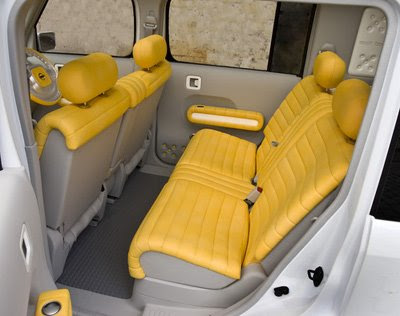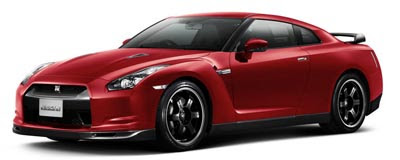MAZDA RYUGA CONCEPT: AN EVOLVED ZOOM-ZOOM
RYUGA ( ree-yoo-ga=Japanese for gracious flow )
The large wheels placed at the far corners of Ryuga's exterior lend a highly stable, balanced stance. The aggressive wedge shape imparts motion even when this sports coupe is parked. Volumes that are small in front, larger at the rear, wrap around and over the wheels to give the exterior tension and direction.
Conducting a guided tour of the exterior, Nakamuta points out several key features:
* Ryuga's side surfaces were inspired by karesansui (Japanese dry gardens). The carefully raked pebbles in these garden s represent peaceful ripples caused by a breeze over a pool of water. The karesansui's man-made image of natural flow is represented in the Ryuga's surface texture to express simplicity and refinement.
* The headlamp shape resembles the flow of morning dew dropping from bamboo leaves. Advanced LED and fluorescent tube technology will enable such a striking design to be used on a production vehicle in the foreseeable future.
* To impart motion, the 21-inch wheel spokes - different on the left and right sides - are slightly twisted as if they're delivering torque. To convey the feeling of gas turbine blades, the trailing edges of the wheel spokes are accented with a tinge of body color.
* Flowing lava inspired both Ryuga's exterior hue and the tail lamp design. Depending on the incident light, Ryuga's surface appears to be shades of yellow, red, and blue, exactly like molten, flowing lava. Notes van den Acker: "The hot red finish goes straight to your heart."
* The roof molding tightens up the flowing cabin and gives an accent to the body styling as well. Cameras located at the forward end of each molding convey rear views to a center cockpit display screen. Turn signals are also integrated into these protruding accents.Reflecting its Japanese origin, Ryuga is both simple and complex. While the dominant flow theme is simple, the details - such as the side surfaces and the wheels - are intricate. Solidity and fluidity live here together, in harmony.
FLOW THROUGH INTERIORThe Ryuga is significantly shorter and lower than today's four-passenger RX-8 sports car, it too accommodates four passengers in roomy comfort. A relatively long (110.2-inch) wheelbase and two large gull-wing doors provide a wide-open invitation to the interior.The doors rise to expose the interior of Ryuga and allow easy slide-in access, the passengers are presented with the fusion of a cockpit - designed to maximize the emotional connection between the car and driver - with the social atmosphere of the rear passenger space, where lounge-like comfort is ensured through expansive space and Nagare-inspired design.
The front bucket seats provide ample lateral support for energetic driving with the shape of the seats creating an impression of movement which is further emphasized by the patterns in the material.The experimental 'floating' center cluster allows a high level of interface between the driver and the multi-function touch panel without having to take one's eyes off the road ahead. Information necessary for safe and dynamic driving is available to the driver with RPM and speed (which is shown in both analog and digital format s ) being displayed on the same axis.
Flowing upwards, the center cluster dynamically penetrates the front information panel which reflects Zoom-Zoom futuristic and sporty design craftsmanship, as well as an integrated interface between man and machine. Elongated pods give the cockpit depth while bringing information closer to the driver's eyes. An open-top steering wheel provides enhanced sight lines to the instruments and the road ahead .
DRIVING PERFORMANCE - ENVIRONMENT AND SAFETY TECHNOLOGIES TO SUPPORT ZOOM-ZOOM
The part of the initiatives, an E85/Gasoline FLEX FUEL engine which runs on sustainable bio fuel could be used in Ryuga. This engine delivers torque and power, balancing driving and environmental performance. Other important features that will support safe driving are the Charge-Coupled Device (CCD) cameras installed for the rear monitoring system and the blind-spot monitoring system. These help ensure safe driving while changing lanes and allow easy identification of potential obstacles. Mazda is working on various technologies to deliver Zoom-Zoom driving in the future, including earth-friendly environmental technologies and people-friendly safety technologies.To ensure the car provides a Zoom-Zoom driving experience, which is the basis behind all the other features, an open top steering wheel is employed with highly sensitive settings to respond to the driver's smallest input. The car also features steer-by-wire technology and gauges that deliver superbly clear information to the driver. The dramatic wheels with TOYO PROXES 245/35R-21 tires complete the driving experience, and the sophisticated original tread pattern perfectly suits the Ryuga's design concept.






























































